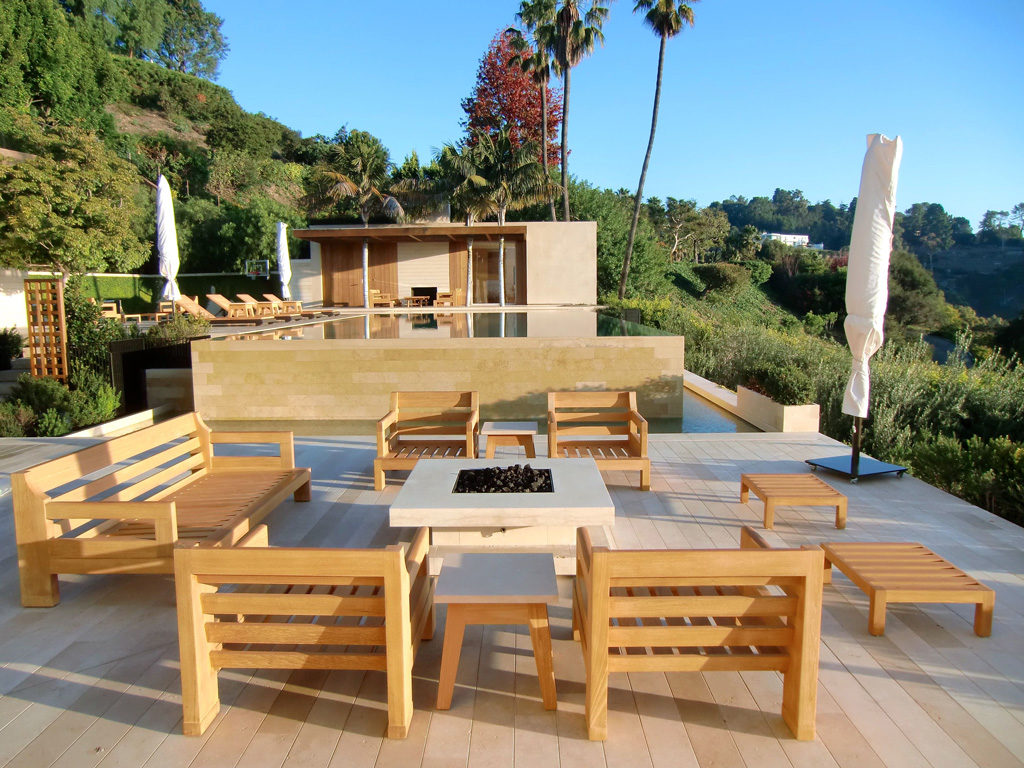Does Teak Furniture Need to Be Sealed?
Teak is an impressively durable and highly valued wood used for both indoor and outdoor furniture. Its natural beauty adds elegance to nearly any type of home decor, whether you’re outfitting a sunroom in nature-inspired materials or upgrading your deck with a sophisticated dining set.
Naturally, homeowners are concerned with the best practices for protecting and preserving their teak’s beauty and value. Sealing is one of many options for keeping your teak in prime condition.
Characteristics of Teak Wood
Fresh teak wood has a natural golden honey hue that’s warm and welcoming in any home. It has a straight grain with a medium luster and a slightly oily feel. The grain has a coarse texture but can be sanded easily to a silky smoothness.
Teak scores 1000 on the Janka hardness scale, which makes it moderately hard. Teak ranks higher than Douglas fir, Southern yellow pine, and black cherry, but it’s slightly softer than black walnut and heart pine. Teak is naturally resistant to nearly all the issues you’ll face with outdoor furniture. It stands up well to water and pests and suffers only minimal shrinkage.
Benefits of Sealing Teak Furniture
Sealing teak furniture is a great way to protect it from the threats of the outdoor environment, especially in the Los Angeles area. Teak can weaken or become stained when exposed to algae, salt water in the air, or airborne pollutants. Teak can also become darkened or streaked by rainwater pollutants.
If your teak furniture sits in direct sunlight, it’ll dry out prematurely and become brittle or splintered. Teak’s color also changes when it’s exposed to the sun. Over time, unsealed teak will lose its warm golden color and fade to a silvery patina. If you seal your teak, it’ll retain that honeyed hue for years to come.
If you eat while seated on your teak furniture, sealing it is a good way to prevent it from getting stained. Olive oil from your grilled veggies, grease from a burger, butter dripping off your corn on the cob, and a splash of wine or coffee can leave unsightly spots on your teak. A teak sealer is essential if you have a teak table or outdoor bench where you expect to eat and drink often.
Cons of Sealing Teak Furniture
The biggest downside to sealing teak furniture is that it won’t take on a silver patina, which is entirely a matter of preference. Some homeowners love the warm shade of the teak, but others love its silvery hue that’s naturally aged over the years. If you like the silvered shade of teak, it’s best to leave it unsealed, at least initially. Once the teak has aged to your preferred patina, you should consider sealing it to keep the shade from changing further.
Types of Sealants for Teak
There are a few different sealants that you can use for teak. When you’re selecting a teak sealer, it’s important to read the label and determine exactly what type of product you’re working with so you’ll know what kind of results to expect.
The first thing to consider is whether your teak sealer has its own varnish. Some sealers are designed to be used in conjunction with a varnish. These sealants adhere to the wood grain but require another topcoat for a smooth finish. Other sealers have the varnish incorporated into their formula, so you only need one product for both purposes.
You should also consider whether you want to use a tinted sealer. This can slightly alter the hue of your teak furniture. You can make it look darker, cooler, or warmer with a slightly tinted product. If you want to highlight and preserve the natural hue of your teak, make sure you have a clear sealant to preserve that color as much as possible.
Application Process and Maintenance
There are several steps that you should follow when you’re applying a sealer to teak furniture. While you can approach this as a DIY job, do note that it’s important to use the right products and tools for the job. If you’re not experienced with this type of project or you don’t have the time and dedication to give it ample attention, you may want to consider hiring a professional. Properly sealing your teak requires you to do the following:
- Clean the surface: Thoroughly clean the surface of your teak furniture. Use a product formulated for teak wood to remove stains without damaging the wood.
- Sand the furniture: Sand down the surface of the teak wood very lightly if you want to retain its silvered patina. Only apply more pressure in areas where it’s absolutely necessary to remove dents and scratches.
- Wipe down the wood: Wipe the wood down lightly to get rid of any dust on the surface, which can create a goopy mess in your sealant.
- Apply the sealant: When the teak is thoroughly cleaned and free from dust, apply your teak sealant. Most products recommend using a brush, sponge, or cloth.
You shouldn’t attempt to refinish teak furniture on your own if it’s suffered from any serious problems, such as mold or mildew growth, major staining, severe splintering, or termite infestation. Though teak is less likely to suffer from these kinds of problems, it’s not immune to them. Contact a professional teak restoration company to properly preserve your teak if you’re facing these kinds of issues.
Schedule Professional Service for Your Teak Furniture
Sealing teak furniture is an important part of ensuring its beauty and longevity. Teak is a great investment and an aesthetically stunning choice, so you want to give it the best care possible. To get the very best results from sealing your teak, contact our professionals at Teak Master in Los Angeles, California. We have the expertise you need to battle the unique threats in this local climate and keep your teak looking beautiful.

